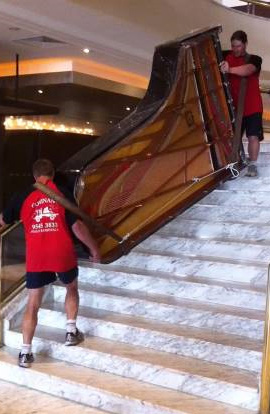Moving or Storing a Piano
Moving pianos
If you are moving to another location, own a piano, and are engaging a removalist to move your furniture, think carefully who to get to move the piano. Most removalists claim they are also piano movers, but all too often do I see damaged pianos, and hear of horror stories from people who had their precious piano moved by a removalist who damaged it. Be advised that common household removalists are certainly not specialized piano movers.
Some owners are not willing to engage a specialist piano mover. They try to save money and asked the removalist if they could also move their piano together with their furniture. Because the removalist does not want to miss out on the entire job, they will tell you that they are also “experienced” piano movers. Their lack of “experience” may well become a very bad and costly experience for you.
 To move a piano safely and properly, one needs much more than just muscle power. It is skillful and dangerous work to handle and manoeuvre a very heavy piano, without doing any damage to the piano, the floors, walls, and doorways of your home. Pianos are prone to fall over because they are also top-heavy.
To move a piano safely and properly, one needs much more than just muscle power. It is skillful and dangerous work to handle and manoeuvre a very heavy piano, without doing any damage to the piano, the floors, walls, and doorways of your home. Pianos are prone to fall over because they are also top-heavy.
The most common damages are scratches, dents, veneer or polyester chipped off the cabinet, pedals that are bent or have broken off. Before removing the legs from a grand piano, the removalist must remove the pedal-lyre to prevent severe damage to the lyre and pedal mechanism. It has happened that household removalists have lost grip of the heavy piano, severely damaging the piano internally and externally.
By all means, be penny wise, but please do not be pound foolish! Have your piano moved by a specialist piano mover who really knows what they are doing. Call us for free advice on whom to engage.
Storing a piano
There are a few facts you need to consider carefully before you place your piano into storage.
Do not treat a piano as if it is a washing machine or a fridge, and never store it in a shed, garage, under a carport or veranda. Pianos are very sensitive to changes in relative humidity. They are easily and quickly damaged or destroyed if exposed to relative humidity above 55% or below 35%. Pianos are primarily made of wood and it is very critical that the moisture content inside the wood is kept constant at all times. Our human body is nowhere near as sensitive to relative humidity changes, but is much more sensitive to temperature changes, and we dress accordingly. Wood does not feel changes in temperature, but does swell and shrink with relative humidity changes. The wooden parts inside the piano are precisely made to very fine tolerances, and swelling or shrinkage outside these fine tolerances will cause extreme damage to a piano. It is wise to have a “Piano Climate Control System” installed to protect your piano.
For more information about protecting your piano from damage, please read our article “The Environment for Pianos.”
Placing blankets or other covers over a piano will not protect it from extreme temperatures and relative humidity. At best, it will keep off dust. Never place a piano into self storage facilities, or storage facilities at removalists that are similar to a shed, garage, or warehouse. The best storage facilities available for your piano are shaded storage units that are inside a building, and even then the relative humidity will fluctuate outside the safe zone of a piano.
The other and better option you have, is to lend your piano to a friend or family member who can look after it properly in a suitable room, and have it tuned.

